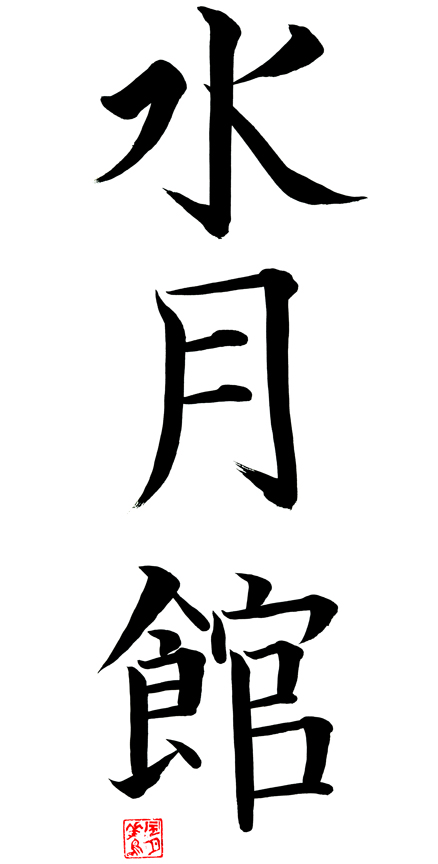Suigetsukan
Suigetsukan translates directly as “moon reflected on water school”. Sui is the Japanese word for water, Getsu means moon, and Kan stands for hall.
The word suigetsu comes from a Buddhist teaching in which it is said that regardless of where a pool of water is, however wide, or deep, or whatever color, the moon will always reflect in the pool as long as the pool is still. In the same way Suigetsukan Dojo will show students their own capabilities, provided the students are prepared to learn.
A brief history of the dojo
Suigetsukan dojo was founded by Sensei Mike Esmailzadeh in 1991 in Berkeley. In 1993 the dojo moved to a warehouse in Oakland where it developed for ten years. In 2003, thanks to the hard work of the students and community, the dojo opened its doors at its current location.
Mike Sensei

Sensei Mike Esmailzadeh is the head instructor of Suigetsukan. He holds the following ranks and licenses:
Shichidan in Danzan Ryu Jujutsu
Professor in Danzan Ryu Jujutsu
Kyoshi in Toyama Ryu Battodo
Rokudan in Toyama Ryu Battodo
Godan in Aikido
He has been actively involved in martial arts since 1976. Mike was born in Germany, and immigrated to the US at the age of 12. Months after arriving in the United States, he began learning Jujutsu under Professor David Bellman. Other Jujutsu Professors, instrumental to his education, are Prof. Tony Muran, Prof. Tim Lynch, Prof. Dom and Helen Carollo. He is equally grateful for the many years of Aikido and Toyama Ryu Battodo instruction he received from Obata Kaiso in those arts. Michael Esmailzadeh is also thankful for having studied the Inayan system of Eskrima under the direction of Mangisursuro Mike Inay, Suro Jason Inay and Masirib Guro Jena Inay. He also wants to thank Shihan Russ Rhodes for the teachings he has provided in that system.
Mike has also trained in a variety of other martial arts/sports, including fencing, wrestling and Iaido. He trained and taught within the Chinese Gung Fu schools of Tai Mantis (Kam Yuen) and Wu Tang (Jason Tsou). He is currently continuing his education in Chinese Martial Arts by studying Bagua Zhang under Maija Soderholm.
In 1990 he left Los Angeles for Oakland, and founded the Suigetsukan Dojo. Suigetsukan now consists of 1700 sq./ft of mat space, and living quarters for Mike and five others. Mike currently teaches Toyama Ryu Battodo, Aikido and Jujutsu. He also co-teaches women’s self-defense classes.
Our relationship to Suigetsukan and Danzan Ryu is one of family in many ways, but perhaps the most curious being that our lines of jujutsu converge in that Professor Henry Okazaki (Danzan Ryu Jujutsu founder) and our Professor Visitacion were very good friends who trained together as sensei and student for many years with Professor Okazaki being the senior and sensei. So if you look closely you may notice a similarity in techniques. This is due to Professor Okazaki's and hence Daito Ryu's influence on Professor V's Vee Jitsu Ryu- predessor to our Sanuces and Tetsunami Jujutsu. Second the longstanding friendship between Mike sensei and Muhammad Sensei has been an example of the kind of commradery a friendship based on the principles of the martial art can foster. Mike Sensei and our Head Instructor Hanshi Muhammad became friends in 1990 and have shared many experiences since.
Danzan Ryu
Danzan Ryu Jujutsu
Jujutsu is an ancient and extremely effective martial art: the mother art of many modern martial disciplines and sports. It includes a comprehensive array of techniques such as strikes, throws, chokes, joint locks and breaks, escapes from holds, use of and defense against weaponry (both ancient and modern), pressure point attacks, meditation and massage. Jujutsu relies not on the strength and size of the practitioner, but rather on a sense of timing and distance and the ability to perform the technique smoothly and by reflex. This ancient art, with its emphasis on building character, community and self-discipline, retains its relevance for the modern world.
Danzan Ryu Aikijutsu
Danzan Ryu Aikijutsu is essentially Danzan Ryu Jujutsu with all of the load-bearing throws replaced by other takedowns. The two reasons for this change are to make the art more relevant to the self-defense needs of smaller people and to make it more accessible to students regardless of age and physical ability. Load-bearing throws require being able to carry another person’s weight and for the person being thrown to then to take a high fall. Though ideally these throws and falls should be done without effort, they are often not the best choice against a larger or stronger opponent. Also learning them can be risky if one has old injuries, particularly to the back or knee. Our Aikijutsu system provides an alternative by replacing these throws with takedowns such as joint locks or foot sweeps that are easier and safer to execute and receive. These changes to the Danzan Ryu system were inspired by Prof. David Bellman’s Mushin Ryu system and Michael Esmailzadeh’s study of Aikido and blend the strongest aspects of all three of these practices.
More on Danzan Ryu History and Philosophy

 武術 Bujutsu
武術 Bujutsu
